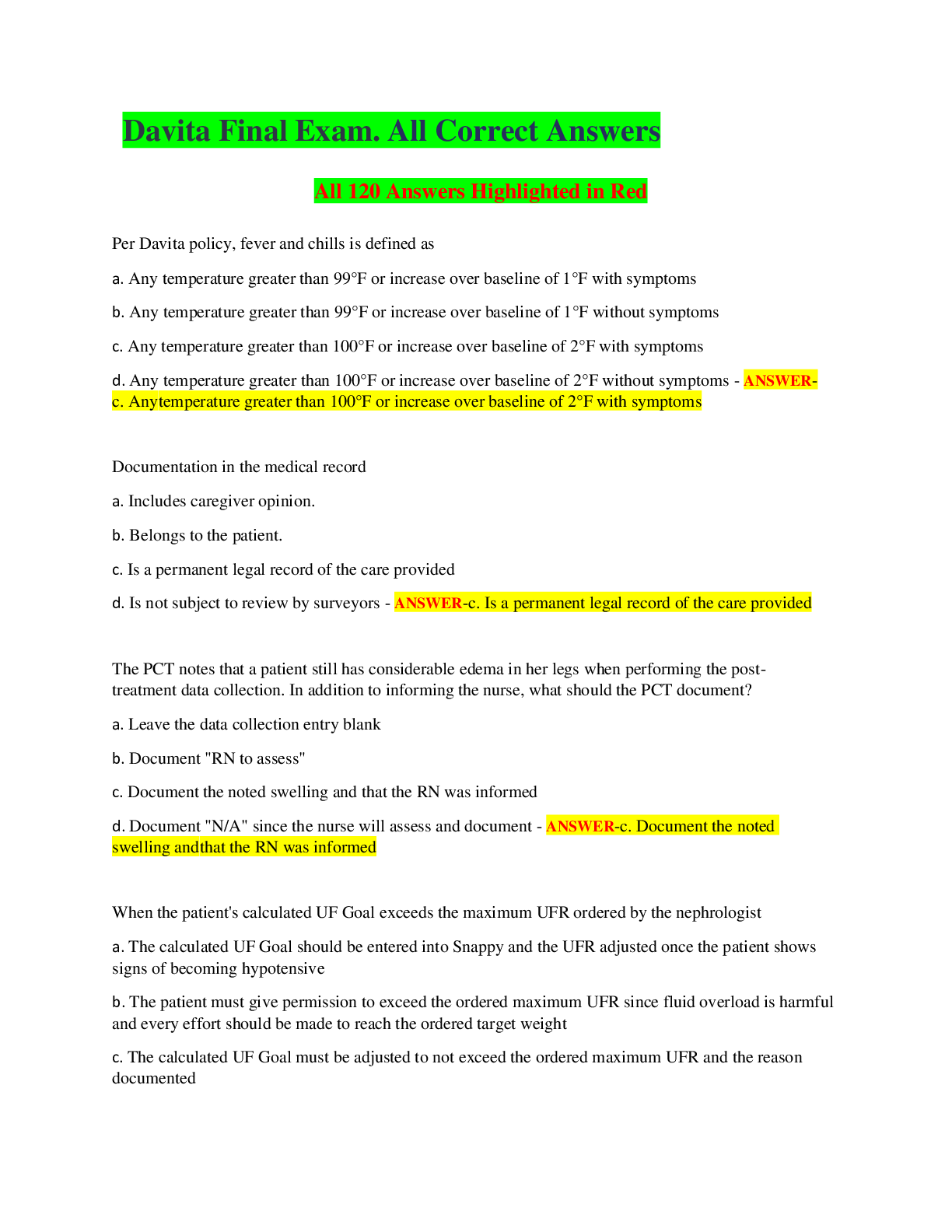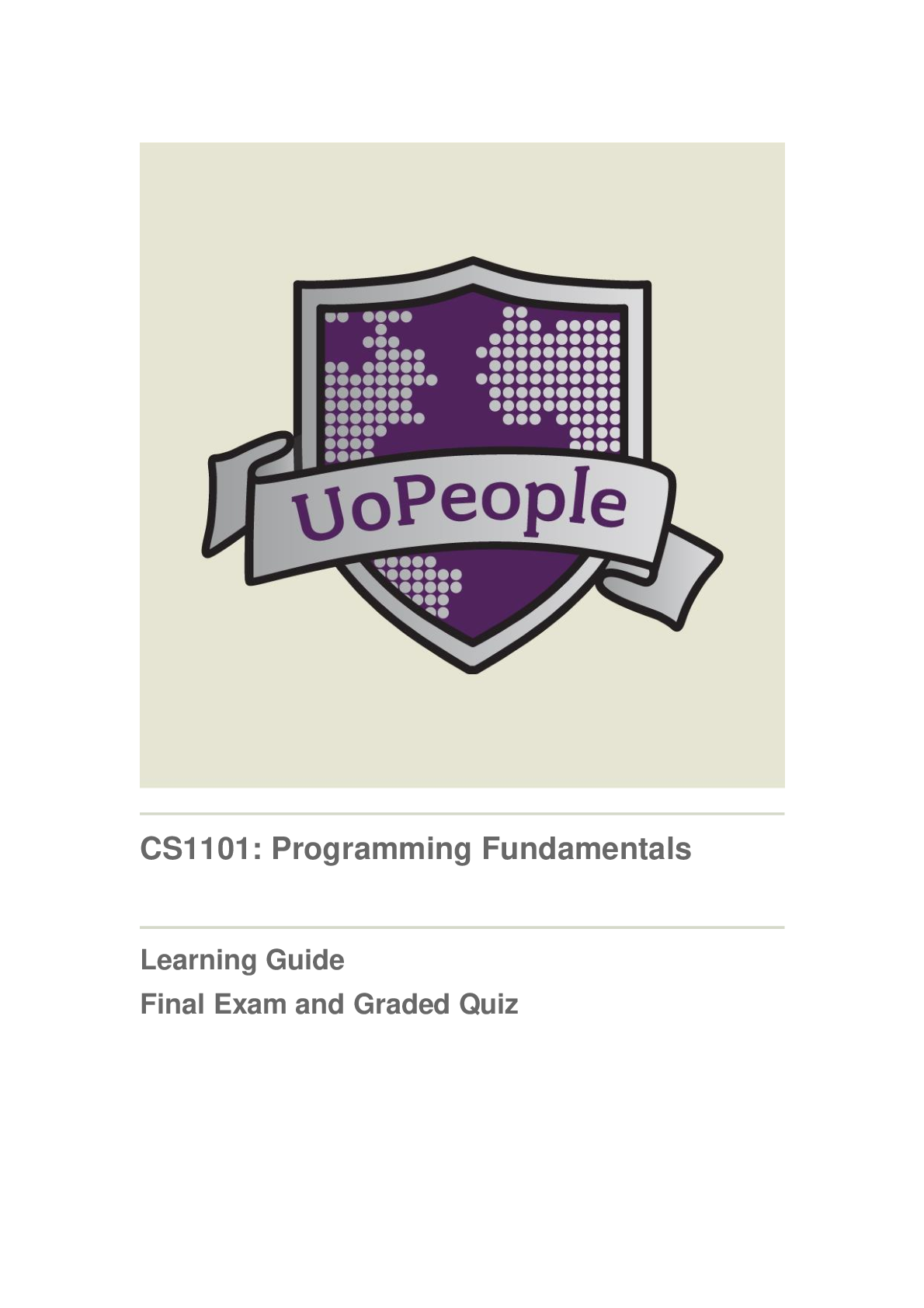Medical Studies > EXAM > Our Lady of Fatima UniversitySCIENCE 000011CPC Practice Exam D_2018_Rationales.docx. correct answers (All)
Our Lady of Fatima UniversitySCIENCE 000011CPC Practice Exam D_2018_Rationales.docx. correct answers revision.
Document Content and Description Below
Question 1 Indication: Patient has a hypertrophic scar on the posterior side of the left leg, at the level of the knee. This has begun to restrict his mobility. His physical therapy trial was unsucc... essful. Procedure: After the proper induction of anesthesia, the subcutaneous tissue of the patient’s left leg beneath the scar was infiltrated with crystalloid solution containing epinephrine to minimize blood loss. The scar was then excised down to viable dermis. Hemostasis was obtained with epinephrine soaked pads. Skin was harvested from the patient’s thigh in a split thickness fashion and was used to cover the 90 sq cm defect created by the surgery. The graft was secured with skin staples, and then dressed with fine mesh gauze followed by medication-soaked gauze. The donor site was dressed with mesh followed by Adaptic™, followed by a dry dressing and an Ace wrap. What are the CPT® codes? A. 15110-52, 15002 B. 15100, 11406 C. 15100, 15002 D. 15110, 15002 The physician is taking a split-thickness skin autograft from the thigh and grafting it to the patient’s left leg, which needs repair. Look in the CPT® Index for Split/Grafts, you are referred to 15100-15101, 15120- 15121. Code 15100 is the correct code because there was less than 100 sq cm taken from the leg (thigh). The second procedure 15002 is reported because the patient had a hypertrophic scar on the leg and the physician is preparing the recipient’s site by excising the scar, which left a 90 sq cm defect, to provide healthy blood vessels onto which the skin graft will be placed. Question 2 The physician is called in to perform repairs for a 17 year-old girl involved in a motor vehicle accident. She sustained an 8.6 cm laceration to her forehead, a 5.5 cm laceration to her right cheek, a 4 cm laceration to her left cheek, a 4 cm laceration across her chin, and a 12.5 cm laceration to her chest. The wound on her chin required a layered closure. All other wounds required complex closure. The CPT® codes to report are: A. 13132, 13133 x 4, 13101, 12052 B. 13132, 13133 x 3, 13133-52, 13101, 13102, 12052 C. 13132, 13133 x 3, 13101, 13102, 12052 D. 13131, 13132, 13133 x 3, 13101, 13102, 12052 First, list all lacerations by the anatomical site and/or the type of wound closure. The only site that has a layered closure is the chin (4 cm), which is coded 12052. The remaining repairs are complex: (Forehead) 8.6 cm + (RT and LT cheek) 9.5 cm = 18.1 cm, which is coded 13132, 13133 x 3 (13132 for the first 7.5 cm and 13133 x 3 for the remaining 10.6 cm). The last site is the chest at 12.5 cm, which is coded 13101, 13102. Question 3 A 36 year-old male presents to have multiple lesions destroyed. Three benign lesions on his face are destroyed and five actinic keratoses on his left arm are destroyed. The CPT® code(s) to report is (are): A. 17000, 17003 B. 17000, 17003 x 4, 17110 C. 17110 D. 17260 x 5, 17110 x 3 Keywords in this scenario are “actinic keratoses,” of which there are five. Code 17000 is the correct code because the code description gives an example of what a “premalignant lesion” is in parenthesis and it is reported for the first lesion being destroyed. Code 17003 has the word “each” in its code description, which indicates each of the four remaining actinic keratoses lesions is reported separately. Code 17110 is the correct code for the destruction of the three benign lesions. Code 17110 is not reported by each lesion separately destroyed because the code description shows to report it once for destroying 1-14 lesions. Question 4 Patient is having ongoing back and hip pain. The physician elects to perform a sacroiliac injection at an ambulatory surgery center. After sterile prep, the patient is placed prone position. A needle is placed under fluoroscopic guidance into the SI joint and a mixture of 20 mg of Celestone and Marcaine is injected for pain relief. Report the CPT® code(s). A. 27096, 77003-26 B. 20611 C. 20552 D. 27096 27096 is the correct code because a steroid injection (Celestone and Marcaine) is placed into the sacroiliac (SI) joint. Fluoroscopic and computed tomography (CT) guidance is included and is not reported separately. There is a parenthetical note under the code description that states: (27096 is to be used only with CT or fluoroscopic imaging confirmation of the intra-articular needle positioning). Question 5 Patient is seen in the hospital’s outpatient surgical area with a diagnosis of a displaced comminuted closed fracture of the lateral condyle, right elbow. An ORIF procedure was performed, which included the following techniques: An incision was made in the area of the lateral epicondyle. This was carried through subcutaneous tissue, and the fracture site was easily exposed. Inspection revealed the fragment to be rotated in two places, about 90 degrees. It was possible to manually reduce this quite easily, and the manipulation resulted in an almost anatomic reduction. This was fixed with two pins driven across the humerus. The pins were cut off below skin level. The wound was closed with plain catgut subcutaneously and 5-0 nylon for the skin. Dressings and a long arm cast were applied. Which is the correct ICD-10-CM and CPT® code assignment? A. 24579-RT, 29065-51-RT, S42.451B B. 24577-RT, S42.451A C. 24579-RT, S42.451A D. 24575-RT, S42.451B The fracture of the lateral condyle is closed because the scenario does not mention that it is an open fracture or documents that a piece of bone has broken through the skin and is exposed. In the ICD-10-CM Alphabetic Index, look for Fracture, traumatic/humerus/lower end/condyle/lateral (displaced). You are referred to code S42.45-. Go to the Tabular List to report the 6th and 7th characters.The seventh character extenders for this code are listed under category code S42. The fracture is closed you have eliminated multiple choice answers A and D. The next step is to figure out if the CPT® fracture care is an opened or closed treatment. Hint: The surgeon made "an incision" to get to the fracture site. Code 24579 is the correct code because this was an open treatment due to the surgeon making an incision to get to the fracture site and performing an internal fixation (two pins). Open reduction and internal fixation (ORIF) is also an indication that an open approach is used to perform the surgery. Question 6 A 35 year-old female patient presents with acute onset of severe pain since October. Her workup has revealed evidence of disk herniation with loss of lordosis at the C5-C6. Intraoperative findings were consistent with two large fragments of free disk fragments in the foramen at C5-C6 on the right side. After general anesthesia, the patient was placed on the operative table in the supine position. All pressure points were cushioned and a transverse skin incision was fashioned under fluoroscopic guidance over the C5-C6 disc space. Dissection through the platysma eventually allowed for exposure of the anterior entrance to the vertebral body of C5 and C6 and retractors were inserted to maintain adequate exposure. The operating microscope was brought into the field. Caspar posts were placed and slight distraction allowed exposure. A complete discectomy was performed at C5-C6 by using endplate curets pituitary rongeurs and Kerrison rongeurs. The posterior longitudinal ligament was resected and beneath the posterior longitudinal ligament, two significant sized disc fragments were noted in the foramen at C5-C6. These were removed using pituitary and Decker instruments. The endplates were then decorticated so that they were parallel to each other and a midline keel was performed on AP and lateral fluoroscopy. A size #1 by 5 mm interbody Kineflex-C device was placed under fluoroscopic [Show More]
Last updated: 2 years ago
Preview 1 out of 24 pages

Buy this document to get the full access instantly
Instant Download Access after purchase
Buy NowInstant download
We Accept:

Reviews( 0 )
$10.00
Can't find what you want? Try our AI powered Search
Document information
Connected school, study & course
About the document
Uploaded On
Jun 07, 2021
Number of pages
24
Written in
Additional information
This document has been written for:
Uploaded
Jun 07, 2021
Downloads
0
Views
69














